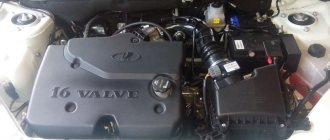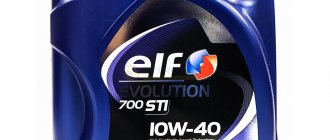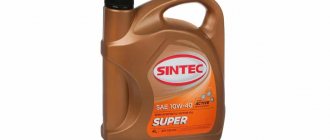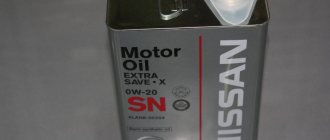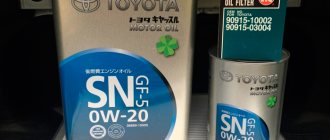Types of oils
All products are divided into three large blocks:
- products for gasoline engines;
- products for diesel engines;
- universal lubricants suitable for engines running on any fuel.
There is another classification of motor oil products:
- summer oils;
- winter oils;
- all-season oils.
This division is due to the fact that different climatic and temperature conditions require different lubricant viscosities. But in this article we will look at how to understand by what characteristics materials are divided into groups and how to choose oil for each season.
Classification of motor oils according to SAE
Each canister of oil has a marking of its viscosity according to SAE. For example:
- 10w40;
- 15w40;
- 5w30, etc.
What do these numbers mean, and how do you know which oil is best to put in your engine for the winter? Let's figure it out.
There are 3 types of lubricating fluid:
- Summer.
- Winter.
- All-season.
It’s worth saying right away that all-season fluids have practically replaced summer and winter oil. Still, it is inconvenient to depend on the weather and change the lubricant when winter or summer comes. Moreover, all-season fluids ensure stable operation over a wide temperature range.
In fairness, it is worth noting that there is:
- 5 summer stamps – 20, 30, 40, 50, 60;
- 6 winter – 0w, 5w, 10w, 15w, 20w, 25w.
All-season fluids are marked as follows: 10w40, 5w30, etc. The number before the letter w (winter) indicates the lower temperature limit at which engine lubrication is ensured during cold starts. The number after - refers to work at positive temperatures.
By the way, you should not assume that these figures are equal to the extreme operating temperatures of the oil. It's a little more complicated. And we'll figure it out soon.
Temperature conditions
Let's figure out what the SAE markings mean and in what temperature conditions they can be used. For clarity, let’s take several brands of oil:
- Mobile Super 5w30 – provides engine lubrication at temperatures down to -30 degrees;
- Lukoil Genezis Polar Special 0w30 is a real extreme, the liquid can withstand temperatures of -40 degrees;
- Zik A+ 10w30 is a universal all-season oil that will provide good cold starts at temperatures down to -25 degrees
- Mobil Ultra 10w40 - a fluid with a higher high-temperature viscosity is best used in warm regions;
- Castrol GTX 15w40 is no longer suitable for cold winters, cold start temperatures are down to -15 degrees.
Thus, you can easily determine which engine oil is best for the winter.
Classification of lubricating petroleum products
Any lubricant has a basic basis that determines its main characteristics. There are several types of base oil:
- mineral;
- synthetic;
- semi-synthetic.
Each of them has its own advantages and disadvantages. For example, the first (mineral) is less financially expensive, but at the same time its properties and retention of characteristics throughout use are at the lowest level. In contrast, synthetic oil has a higher price, but the quality of this consumable is much better. Semi-synthetic motor oil balances between these two options.
If we talk about viscosity, it makes sense to look at the SAE system - a special generally accepted classification of motor oils created by the US Society of Automotive Engineers. This classification will help you learn more about the characteristics of the working environment, its effect on engine starting, fluidity and viscosity, and the ability to pump.
Present categories
In summer and winter, it is recommended to use different oils. Therefore they are divided into categories:
Winter
The use of such oils is possible only in winter. In summer, their use will not provide a sufficient oil film on the parts. This will happen because in hot conditions the viscosity of the oil decreases. As a result, engine life is reduced.
Summer
These oils have a high level of viscosity in hot conditions. In winter, it increases even more, which leads to insufficient lubrication of the engine.
All-season
These oils are universal. They provide a sufficient degree of viscosity at any time of the year.
All-season oils are popular among car enthusiasts. They should be used especially in winter, when there are no severe frosts.
Motor oils for summer and winter: their properties and differences
The division of lubricants by season is due to the fact that any oil thickens at low temperatures, and at high temperatures acquires a more liquid consistency. Therefore, for the summer period there is a need to choose more viscous products. If we refer to the SAE system, which we discussed above, the classification of lubricants for the warm season should be in the range from 20 to 60. These numbers indicate viscosity - the higher the number, the higher the viscosity.
When it comes to winter, choose products that have a viscosity of 0W to 20W according to the SAE classification. We have already dealt with the numbers, and the letter W here means the cold season (winter). Its addition indicates that the viscosity is indicated for low temperatures. That is, if we see the letter W in the oil characteristics, we understand that it is winter. If W is missing, then the lubricant is intended for summer.
Winter and summer engine oils: what are the differences
The main properties of motor oil depend on its base. The basis is the so-called “base”. This is a base to which a package of special additives is also added. Said base oil can be mineral, semi-synthetic or synthetic. Mineral is considered the most affordable option, while the period of preservation of useful properties during operation, as well as a number of other characteristics, is at the lowest level. Accordingly, semi-synthetics are an “intermediate” link between affordable “mineral water” and expensive “synthetics”.
As for classification, the generally accepted system is SAE (US Society of Automotive Engineers classification of motor oils). According to the SAE classification, you can obtain information about the viscosity of the lubricant at high and low temperatures, fluidity properties, pumpability, effect on engine starting, etc.
We also recommend reading the article about whether it is worth using an engine flush before changing the oil. From this article you will learn about the advantages and disadvantages of such a solution.
Taking into account the fact that any oil thickens at subzero temperatures and thins out when heated, there has traditionally been a division into winter and summer oils. It turned out the following: summer oils for cars should be more viscous. These include lubricants classified from SAE 20 to 60. The indicated value reflects the viscosity. The higher the number, the more viscous the summer oil is.
The group of winter lubricants usually includes products according to SAE with the following designation: from SAE 0W to SAE 20W. The letter W is an abbreviation for winter. In other words, for example, SAE 15 W indicates that this oil is winter. In both the first and second cases, the number indicates the viscosity. The addition of the letter W is an indicator of viscosity at low temperatures, allowing you to accurately determine which oil is summer and which is winter.
All-season lubricants
In the modern world, the separation of working fluid depending on expected temperatures is no longer so relevant. Now there is an all-season motor oil, thanks to which the need to change the lubricant between the warm and cold seasons has disappeared. Today it is not so easy to purchase a product only for summer or only for winter - they are not on sale so often.
According to the SAE classification, all-season oil has its own designation - this is a peculiar combination of markings for summer and winter lubricants. The designations 0W-30, 20W-40 and the like indicate that we are talking about an all-season working fluid; they contain two numbers indicating the viscosity. The first indicates viscosity in the cold season, the second - in the warm season.
Along with viscosity, it is necessary to pay attention to a number of characteristics.
We take into account the degree of engine wear
Synthetic oils are the most modern product made using the synthesis of petroleum and other ingredients. They preserve their properties better than other types of oils and are suitable for engines of varying degrees of wear.
Semi-synthetic ones are recommended for use in engines of modern vehicles with high mileage.
There are no additives in mineral oils. This product is used for older engines without harsh operating conditions.
When purchasing a lubricant product, it is necessary to take into account various factors, ranging from the operating conditions of the vehicle to the degree of boost of the internal combustion engine. It would be quite correct to purchase one SAE all-season motor oil recommended by the manufacturer for a specific engine type.
How to choose engine oil for summer and winter
When choosing oil for the summer period, it is necessary to give preference to the most suitable one from the variety of all-season oils. The degree of compliance with the requirements is determined by the viscosity value indicated for high temperatures and the conditions of use of the vehicle.
Consider temperature changes in your region. If we talk about winter, the lower the thermometer drops, the lower the number should be indicated after the SAE abbreviation. Zero-value lubrication allows the engine to start easily even in cold weather, reduces friction inside it and helps reduce fuel consumption. But at too high temperatures, such a product can become very liquefied and provide insufficient protection. Therefore, car owners often prefer more viscous oils.
It is important that for different types of motors the use of a certain range of lubricants is allowed. Therefore, it is recommended to study the instructions/manual for the car to obtain information about the permitted products for your car.
If the actual temperature readings are noticeably (by 10 degrees or more) and consistently different from those indicated in the manual, this may be a good reason for a seasonal replacement of the lubricant.
Scope and features
The scope of application of modern lubricants for internal combustion engines is determined by their properties. Therefore, in order to determine which oil is best to pour into a diesel or gasoline engine, you need to know its cleaning characteristics, as well as its parameters for preventing wear and oxidation. For this purpose, special oil classification systems have been created that are used all over the world:
- SAE - divides all motor lubricants into 5 five summer (marked by numbers) and six winter (marked by the letter “W”) classes. “All Season” in this case has a double (numbers + letters) designation.
- API - separates motor lubricants according to their intended purpose. Oils for diesel engines receive the symbol “C”, and gasoline ones, respectively, “S”. Universal products that can be used in any internal combustion engine are distinguished by the markings of the two above-mentioned categories.
- ACEA is a system that includes 3 classes and 11 categories of motor oils. Class “A / B” is aimed at use in passenger cars with gasoline and diesel engines, “C” implies compatibility with exhaust system neutralizers, and “E” is designed for trucks equipped with diesel power plants.
- ILSAC is another international standard for motor oils, which includes three classes of lubricants used in engines running on light fuel (GF -1/2/3).
Indications for changing the oil
In addition to climatic conditions, engine wear also affects oil changes. With operation, the gaps in the friction pairs may become larger; in order to smooth out the consequences of this change in the engine, reduce noise and increase the operating life of the unit, there is a reason to fill in products with a higher viscosity.
In the warm season, this is especially important, since it is in the summer that the car drives at high speeds and it is in the summer that the temperature inside the engine increases as much as possible. An example of switching from one product to another, taking into account the above-described features: replace SAE 5W-30 oil with 5W-40 after a hundred to one and a half kilometers, and if the degree of engine wear is high, then you can even fill in products with a viscosity of 15W-40 or 20W-40.
Which oil to choose?
Among the many oils, which oil should you pour into your engine in winter? Since most types of products on the market are all-season, replacing it may not be necessary if it is selected correctly. However, if the lubricant has used up 2/3 of its service life, then it is better to produce it.
However, it is better to fill the engine with oil in winter, taking into account the parameters recommended by the manufacturer of the vehicle itself. You can look at the instruction manual and select 1-2 items from the recommended ones. The following characteristics will depend on the quality and parameters of the material:
- noise level during operation of the power unit;
- difficulty starting in cold weather;
- fuel consumption;
- duration of motor life.
Lubricant mixtures with higher viscosity form a thick film that reliably protects the metal elements of the engine. It is also worth saying that less carbon deposits are formed, the engine runs noticeably quieter, and the likelihood of leakage through seals and gaskets is reduced. What viscosity should I use for the engine in winter? First of all, it is necessary to evaluate recommendations and tolerances, especially for power units that have traveled more than 100 thousand kilometers.
In such a situation, many people tend to add mixtures with higher viscosity to the system, and this makes sense, since the gaps increase with mileage. But we must not forget that viscous oils become thicker when frozen and cannot fully flow around the mechanisms. Therefore, even if the engine started easily in the summer, difficulties may arise in the winter.
But how can you check the condition of the oil before the onset of cold weather in order to be ready to change it? Before starting the internal combustion engine, we first remove the oil dipstick and evaluate not only the level, but also the density, as well as the speed at which a drop flows onto the tip of the dipstick. A lubricant that is too thick indicates that it is better to change it before winter.
In order to understand the correct level of lubricant in the system, it is better to do this not on a cold engine. First, it is warmed up at idle, and then you will need to drive several hundred meters. During this time, the material warms up and occupies a slightly different volume. After this, the engine must be turned off and allowed to cool for up to 10 minutes. During this time, the diluted oil for filling in winter flows into the crankcase of the power unit. Now you can pull out the dipstick and make an objective assessment of its volume in the system.
In order to make the right choice, you should definitely pay attention to the labeling indicated on the packaging. The so-called “winter” varieties are marked with the letter W, which stands for the word “winter” (winter, from English). The common line for passenger cars is in the range between 0W30 to 10W40. The first will be as fluid as possible and even in severe frosts it can be easily pumped by the pump.
Let's summarize
Since summer-only or winter-only lubricants are very rarely commercially available, pay attention to the viscosity of all-season oils for low and high temperatures.
When purchasing oil, determine for yourself which base is preferable - inexpensive mineral or high-quality synthetic.
Do not forget that mineral-based products are cheaper, but are significantly inferior to synthetic ones in properties and quality. The latter can protect the engine from wear and damage much more effectively.
When choosing a working environment, take into account the temperature regime, the conditions of use of the vehicle and the degree of boost of the power unit. Often, the best option is multi-season oil, the regular change of which will be more profitable and easier than replacing a summer oil product with a winter one and vice versa. Choose a lubricant recommended by the manufacturer for your specific engine type.
What is viscosity index and oil dilution degree?
The performance characteristics of a particular oil from different brands are compared based on key parameters, one of which is viscosity. The strength of the lubricating film that forms on the piston group and other parts of the engine depends on the viscosity index. Thicker oil with a thick and durable film increases the load on the internal combustion engine and reduces its efficiency, while a thinner film is not able to provide maximum protection for the internal combustion engine from wear and dry friction for a long time.
Therefore, for stable engine operation in the winter, a compromise solution is needed, which is oil with moderate viscosity - that is, not too thick so that the oil retains its fluidity after the engine warms up. When used in summer, the requirements are not so serious, so you can even fill in thick oil, because it still won’t freeze at above-zero temperatures.
On the packaging of the canister, the manufacturer indicates the viscosity index, which determines the thickness of the oil. With a lower index, the oil loses its thickness, and the protective film of such a liquid is thinner. Because of this, it is recommended to shorten the oil change period, otherwise premature wear of internal combustion engine parts is possible due to a thinner oil film. Oil with a high index is distinguished by its thickness and less fluidity. This allows you to envelop the internal combustion engine parts with a durable and thick oil film, which retains its structure for a long time and increases the oil change interval.
Using the viscosity index, you can determine the degree of dilution of the oil. After starting, the engine begins to warm up, and as it warms up, the oil gradually dilutes, which at the same time becomes less frequent due to the increase in temperature. In essence, the degree of dilution is the viscosity index, presented on paper as a simple numerical value without units of measurement. Below are common indices depending on the type of oil.
- Mineral oil – 110-135
- Semi-synthetics – 130-150
- Synthetics – 140-170
This is why synthetic oil is best suited for winter use, because it has the highest viscosity index. Mineral oil, due to its lower index, on the contrary, ages faster and loses its performance characteristics, which is why it is necessary to reduce the replacement schedule. In the summer, any viscosity index is suitable, but before the onset of winter it is better to switch to synthetics or, in extreme cases, semi-synthetics.
SAE classification
To determine the appropriate winter or summer oil, you need to familiarize yourself with the so-called SAE classification, which varies depending on the viscosity of the lubricant. So, SAE has different markings - 0W, 10W, 20W, 25W, etc. For example, in an oil marked 5W-30, the number “5” indicates the maximum sub-zero temperature for which the oil is designed. Next comes the letter “W”, which makes it possible to use this oil in the winter season. The number “30” is the maximum temperature unit for positive temperature at which the lubricant retains its performance characteristics.
So, let's look at the most common SAE classifications to understand their purpose depending on weather conditions, engine type and vehicle condition:
- 5W-30/5W-40 is the most versatile and widespread oil with good temperature resistance. It is used for diesel and gasoline cars
- 0W-20/0W-30 - this SAE viscosity is recommended for use in the northern and central regions of the Russian Federation with harsh climatic conditions
- 0W-40/0W-50 - specific all-season oil, not suitable for all types of internal combustion engines
- 10W-30 is another universal oil that is suitable for operation at positive and low temperatures below 25 degrees
- 10W-40 is the optimal SAE option for the southern regions of the Russian Federation with a mild climate
- 15W-40 – recommended for diesel and gasoline cars with high mileage
How to determine the seasonality of oil according to SAE
To consolidate the above material, the SAE classification can be divided into three groups of oils:
Winter - marked 0W, 5W, 10W, 15W, 20W, 25W. The number in this case indicates the maximum permissible sub-zero temperature, and the letter W means winter oil
Summer - marked 20, 30, 40, 50 and 60, where the number indicates the maximum permissible positive temperature above 0 degrees Celsius
All-season oil is the most popular oil. It is universal due to the fact that it does not have to be changed before the winter season or with the arrival of spring. In other words, you can drive with this oil all year round. The marking of all-season oil is as follows:
- 0W-30 – suitable for temperatures from -30 to +20 degrees.
- 0W-40 – for temperatures from -30 to +35 degrees.
- 5W-30 – from -25 to +20 g.
- 5w-40 – from -25 to +35 gr.
- 10W-30 – from -20 to +30 gr.
- 10W-40 – from -20 to +35 gr.
- 15W-40 – from -15 to +45 gr.
- 20W-40 – from -10 to +45 gr.
API classification
Let's briefly consider the API classification so as not to encounter incomprehensible designations when choosing a suitable winter/summer oil depending on the type of internal combustion engine and the year of manufacture of the car - in fact, these are the main indicators from which to proceed when selecting the optimal API classification, which is indicated in in the form of various symbols:
C - for diesel engines S - for gasoline engines S/C - can be used for diesel engines, but is better suited for gasoline internal combustion engines C/S - on the contrary, better for diesel engines, but in extreme cases it is also suitable for gasoline engines
After one of these letters there is a second letter, which, in ascending alphabetical order, determines the compatibility of the oil with more modern or older cars.
For example, API-SL and API-SN for old and new gasoline cars, respectively. The same situation is with diesel engines - API-CI and API-SJ for old and new car models, respectively.
ACEA classification
Let's briefly consider the ACEA classification so that when studying the characteristics of a suitable winter/summer oil, there are no unclear designations. The ACEA classification is first designated by a letter indicating the engine type. Next comes the number - the higher it is, the higher quality the oil is and is suitable for modern engines (or vice versa).
A – for petrol B – for diesel engines E – for diesel trucks C – universal oil for petrol and diesel engines
What is the difference between 5w40 or 10w40 motor oils and which is better for summer?
Greetings, friends!
In this article we will talk in simple language about the differences between 5w40 and 10w40 oils, and which one is better for use in the summer. So,
Most 5W-40 oils are synthetic oils and are recommended for use in newer engines, since such engines are demanding not only on the viscosity of the oils, but also on their composition. 5W-40 is inferior in viscosity to the top ten, due to a decrease in the “winter coefficient”. The car will start better in winter. But when operating temperature is reached, the oils provide absolutely identical protection.
10W-40 is recommended for vehicles manufactured in the early 2000s. 10 is cheaper and is often semi-synthetic. There are also completely synthetic specimens, but they are found on the market very rarely.
If you look at the typical viscosity indicator of these oils at an operating temperature of 100 degrees, then the viscosity indicators will be the same (12.5-16.3 mm2/s). 5W-40 has an advantage only in winter, for easier engine starting.
We will compare oils from the manufacturer Lukoil Lux. 5W-40 synthetics and semi-synthetics 10W-40. Of course, this will give some distortions, but still not large and they will not have a serious impact on the result.
According to the study, the high temperature index of the oils is identical, but the flash point is higher at 5. This is not surprising, since 5W-40 is a synthetic oil. This suggests that when choosing an oil you do not need to rely only on SAE indicators. It is worth paying attention to the production technology and composition of the oil.
If we talk about oil viscosity, 10W-40 is a little thicker. If you compare 5W-40 and 5W-30, the first will be twice as thin as the second oil. So the viscosity values are almost the same and it’s worth choosing the oil that the engine manufacturer recommends.
In winter, the difference between the oils is almost imperceptible. Both of these oils allow you to safely start the engine even at temperatures of -30 degrees.
Which oil is better?
The best oil for your engine will be the one specified by the manufacturer. For older engines, 10W-40 is better. Due to its higher viscosity, it will reduce oil consumption. For newer engines it is better to use five.
Which oil is best for summer conditions?
5w40 oil most often has a higher viscosity index (viscosity does not change as much with temperature changes) than 10w40 and therefore has a higher viscosity at temperatures above 100°. And this temperature exists on the cylinder walls and on the exhaust valve stems. Therefore, it protects better than 10w40 these parts working in extremely unfavorable conditions, especially in the heat of summer.
Can these oils be mixed with each other?
You can mix it, but you definitely shouldn’t overuse it. And if you mix, you need to choose oils from the same manufacturer. When mixing oils, you can lower or increase the viscosity, depending on the amount of oil of one brand. You also need to take into account the composition of the oil.
Thank you for your attention! If the article was interesting or useful, give it a thumbs up. All the best!
Source
